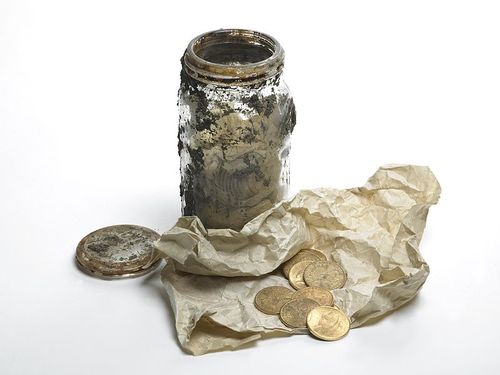Jar O' Coins
 A jar has 1000 coins, of which 999 are fair and 1 is double-headed. Pick a coin at random, and toss it 10 times. Given that you see 10 heads, what is the probability that the next toss of that coin is also a head? Give your answer to 3 significant figures.
A jar has 1000 coins, of which 999 are fair and 1 is double-headed. Pick a coin at random, and toss it 10 times. Given that you see 10 heads, what is the probability that the next toss of that coin is also a head? Give your answer to 3 significant figures.
Image credit: Wikipedia Portable Antiquities Scheme
The answer is 0.753.
This section requires Javascript.
You are seeing this because something didn't load right. We suggest you, (a) try
refreshing the page, (b) enabling javascript if it is disabled on your browser and,
finally, (c)
loading the
non-javascript version of this page
. We're sorry about the hassle.
2 solutions
Sometimes in probability, making a detailed flowchart helps. This whole calculation could be done with more ease.
Hmm... I'm quite confused.
Does seeing 10 heads come into calculation?
If a fair coin is tossed 10 times and you see head, the probability that you see a heads after that would still be 1/2 wouldn't it?
Also, the coin is picked at random so it wouldn't matter that the coin showed three heads.
I'm really confused. Can someone explain?
Log in to reply
The 10 heads are used to calculate the probabilty of the coin being fair or double-headed.
Let A denote the event that the unbiased coin is chosen. B denote the event that first 10 tosses results in head, and C denote the event that 11th toss results in head. Now, we need to find P(C) observe that P ( C ) = P ( C ∣ A ) P ( A ) + P ( C ∣ A c ) P ( A c ) but since it is given that the event B has occurred, we update P(A) with P(A/B) and P ( A c ) with P ( A c ∣ B ) Thus, P ( C ) = P ( C ∣ A ) P ( A ∣ B ) + P ( C ∣ A c ) P ( A c ∣ B Now, we have P ( A ) = 1 0 0 0 1 ; P ( A c ) = 1 0 0 0 9 9 9 P ( B ∣ A ) = 1 P ( B ∣ A c ) = 2 1 0 1 = 1 0 2 4 1 using bayes theorem P ( A ∣ B ) = P ( B ∣ A ) P ( A ) + P ( B ∣ A c ) P ( A c ) P ( B ∣ A ) P ( A ) P ( A c ∣ B ) = P ( B ∣ A ) P ( A ) + P ( B ∣ A c ) P ( A c ) P ( B ∣ A c ) P ( A c ) A little arithmetic gives P ( A ∣ B ) = 2 0 2 3 1 0 2 4 P ( A c ∣ B ) = 2 0 2 3 9 9 9 using these values on the 2nd equation, and after little more computations we get P ( C ) = 4 0 4 6 3 0 4 7 = 0 . 7 5 3
We are told that the coin flipped gave 10 heads in a row. P(10 heads)= 1 0 0 0 9 9 9 × ( 2 1 ) 1 0 + 1 0 0 0 1
From this, we can find out the following:
P(fair coin) = 1 0 0 0 9 9 9 × ( 2 1 ) 1 0 + 1 0 0 0 1 1 0 0 0 9 9 9 × ( 2 1 ) 1 0 = 2 0 2 3 9 9 9
P(double headed) = 1 0 0 0 9 9 9 × ( 2 1 ) 1 0 + 1 0 0 0 1 1 0 0 0 1 = 2 0 2 3 1 0 2 4
Knowing this, we can then find out the probability of the next toss of the coin being a head: P(head) = 2 0 2 3 9 9 9 × 2 1 + 2 0 2 3 1 0 2 4 = 4 0 4 6 3 0 4 7